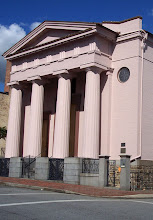Monday, December 29, 2008
It's been a while..
Monday, November 24, 2008
Into the Void
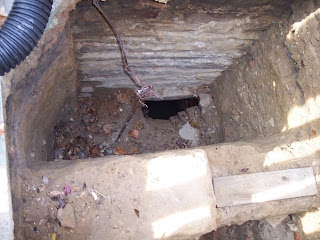
Just to refresh your memory, this is what the entrance to The Void looks like. We did break away two more bricks, just to give me a little more wiggle room.
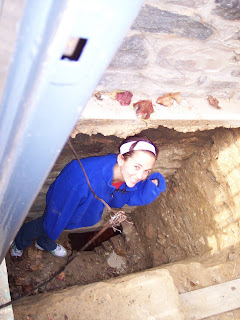
Me, getting ready to go into the cistern.
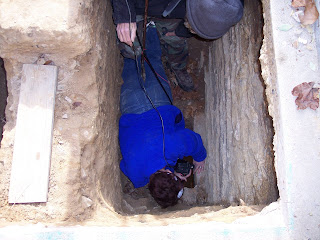
Testing the set up and making sure that both the camera and I will fit into the opening.

Me, halfway in the hole, with Peter Middleton sitting on my legs in lieu of a rope.
Thursday, November 6, 2008
Front Doors Faux Graining
Next, the doors receive a layer of glaze that is combed to resemble the pore structure of oak. (see bottom part of the door).
The doors are then hand-painted to resemble figure graining. The paint is waterbased oil paint mixed with glazing liquid. The work is combed to break up the lines.


Next is the toning layer. Subtle nuances are given to each board to create variation.
Finally, the doors are clear coated with spar varnish, which protects them from the sun and elements. This is the same kind of varnish used on boats and other outside objects.
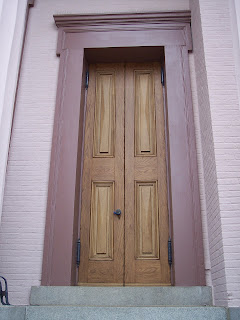
The Void is Drained!
Friday, October 31, 2008
Once Upon a Time Photos: 10.31.08
Date(s) run in Baltimore Jewish Times: 10/31/08
PastPerfect Accession #: 1985.159.032
Thanks to Babette Goldschmidt, Selma Frank, Stan Heyman, Mark Rosenfield, Phil Shapiro, Jane Kaufman, Jerry Shavrick, Rina Levy, Judge Edgar Silver, Jerry Esterson, Gloria Kolker Hack, Andrew Cohen, Marian Block, Gordon Salganik, Sheila Manson, Marilyn Silverstein, Rabbi Moses Shevalsky, Edna Hendler, Barbara Ravitz, Carl Kupfer, and Robin I. Cushner

Wednesday, October 29, 2008
Picture Post

The crevice that leads into The Void.

Close-up of crevice. Notice that there is 4'+ of water in the bottom of The Void.

Curatorial Assistant Jennifer Vess in the archaeology pit.

Project Manager Lacy LeBlanc in the archaeology pit.

Ceiling and side of The Void.

Brick siding near the top of The Void.

The camera screen that allowed the archaeologists and plumbers to watch the feed from The Void in real time.

Lacy lowering the camera into The Void.

Watching the live feed from the camera.

The pump.
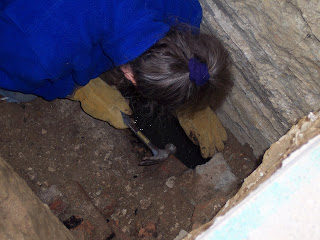
Archaeologist Esther Read widening the hole so that the pump could be lowered into the water.

The pump is in the water.
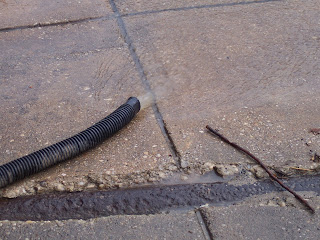

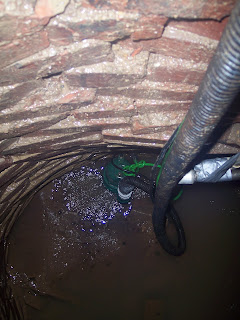
Almost empty!

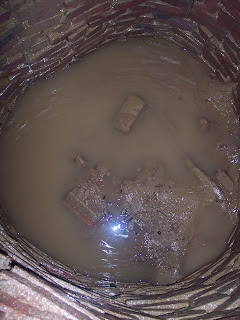
The bottom of The Void.

Monday, October 27, 2008
"We're not sure at this time what we're looking at, i.e.., a cistern, a dry well, or ?; Esther and Garry [Stone, Architectural Historian] will be sharing their thoughts on this. From the photos the structure appears to be cylindrical, which I measured at 3'-6' in diameter. It is about 8' deep, with four feet of standing water; the walls appear to be dry laid brick. It is unclear how the LSS foundation spans the hole; presumably there is a large stone [lentel]. Note that the photos [see below] are the only visual we have at this time, since the location directly under the foundation does not currently allow enough room to fit one's head down to get a good look!
[...]
Note that the cistern may be the principal cause of the settlement and stresses at this corner, but there are several other suspected influences, and the dramatic subsidence in this area is likely a consequence of the compounded influence of several or all factors including (1) the broken sanitary line dating from @ 1900, (2) the 8" sanitary line installed about 1960, (3) that a portion of the south wall rests on fragments of the brick wall of the mikvah house."
Once we have had a chance to investigate the interior of the cistern, we will discuss the best way to proceed with the grout injection that will stabilize the SE corner of the LSS. Since the cistern appears to be dry-laid, there is a fairly good chance that the pressure grouting which had been planned will not be an option in the area around the cistern. The high pressure aspect of pressure grouting could potentially damage the cistern and the surrounding area, and as with every aspect of this project, we will not proceed until the best options have been determined and agreed upon by our various historic and preservation specialists.

The 1" x 6" hole at the bottom of the pit that led to the discovery of the cistern.



The interior of the cistern - at least as much of it as we can currently see.
Thursday, October 23, 2008
Of Cisterns and Synagogues
We do, however, have an idea about its purpose. During her first dig onsite (1999 - 2001), Esther speculated that there would be a cistern associated with the original mikveh. Because of the location of the "void," we know that it pre-dates the expansion of the synagogue, which puts it in the correct time frame for Esther's original speculation.
What does that mean for the renovation/restoration process? Well, immediately, it means more meetings. Over the next week, both the archaeology and grout injection will be put on hold until we can meet with the archaeologists, historic building specialists, and representatives from the Maryland Historical Trust. The long-term results remain to be seen.
Monday, October 6, 2008
Playing in the Dirt
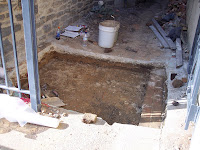
Thursday, October 2, 2008
Cleaning the LSS






*Cleaning solutions tested are as follows:
1) 2% solution of Murphy's Oil Soap and distilled water
2) 2% solution of Simple Green and distilled water
3) 2% solution of Fantastik and distilled water
4) 2% solution of Vulpex and distilled water
5) 2% solution of Vulpex and mineral spirits
Thursday, September 18, 2008
What a difference a day makes!
This was the LSS on Tuesday.

And this is today.

Artifacts in the Fridge?
According to The New Museum Registration Methods, the primary sources of damage to historic artifacts come form light, heat, humidity, and infestation. What could you use to store artifacts in a pinch? The fridge! So, I sent out one of the strangest emails in my life, notifying the rest of the staff that we were now storing historic artifacts in the vegetable crisper.
Luckily, the objects did not have to stay there long. They are now safely stored in the coldest office in our building, awaiting further examination. (Many thanks to Deb Weiner for volunteering her office.)
Wednesday, August 20, 2008
From the desk of Avi Decter
Over its entire history of occupation and use as a house of worship (1845-c.1960), the LSS's brick body (as well as the exterior woodwork) was painted. The color schemes changed substantially over the decades, in keeping with changing fashion and taste and with the means of the several congregations who worshipped there.
At its dedication in 1845, the portico and the brick body of the building were painted "one uniform stone tint" (Isaac Leeser in The Israelite). When the building was expanded in 1860, the color of the portico and the brickwork was painted a pinkish-beige-grey (taupe) color; the window frames, window sash, and door frames were painted a dark brown, resembling brownstone; and the front doors were painted (grained) to resemble dark oak. This color scheme is documented in an 1864 photograph now in the JMM collection and substantiated by historic paint analysis.
In later periods, the exterior colors varied widely, and by 1958, the brick body was painted brick-red with white painted lines to simulate mortar lines - a paint scheme, in other words, designed to look like the underlying brick body! In 1963 - 64, the brick exterior was sandblasted, removing all the prior coats of historic paint (save for a few surviving fragments) - and destroying the glaze finish on the brickwork, as well.
In researching and planning for preservation work at the LSS, the JMM and its team of consultants (including a preservation architect, architectural historian, and historic paint analyst) have concluded that the best documented and most appropriate exterior color scheme, both from interpretive and preservation perspectives, would be to restore the exterior color scheme of the 1860s. This will comport well with the color scheme of the main sanctuary, which has been returned to c. 1871.
The change in exterior appearance may be startling to some observers, but its appearance in the past 44 years was a finish scheme that never was used throughout the building's 116 years as an active house of worship. The new color scheme now in progress will offer thousands of annual visitors a more authentic, accurate impression of a great Maryland landmark. Our decision, along with the historical documentation to support it, will be included in our interpretive tours and signage.
Painting the LSS
Tuesday, August 12, 2008
What's with all this scaffolding?
“The Jewish Museum of Maryland formally requests [Maryland Historic] Trust approval to restore the c. 1864 exterior color scheme and finishes of the historic Lloyd Street Synagogue (LSS). The structure that we see today from the outside of the building dates to 1860; the present exterior colors and finishes, however, date mostly to 1963-65, when the building was restored by the Jewish Historical Society of Maryland.” –
-------
Through extensive archaeological and archival research, we have discovered that appearance of the LSS has gone through extensive changes – almost from the very moment it was completed. “Throughout its history of occupancy and use by three successive immigrant congregations, 1845-1963, all or portions of the LSS’s brick exterior was painted; color schemes on the portico and stationary woodwork varied tremendously; the main (west) doors were grained repeatedly; and the stone foundation walls were at one point covered in stucco, colored and scored to resemble ashlar. In short, the LSS exterior as we see it today is neither accurate nor authentic to any of this landmark’s periods of historical or architectural significance!” (Decter).
During the restoration of the 1960s, the building was stripped of paint, sand blasted, cleaned, and repainted to what was assumed to be the original appearance. Very little of the original paintwork remained, but through the work of many professionals, including Garry Wheeler Stone, architectural historian, John Srygley, preservation architect, and Matthew Mosca, historic paint consultant, we have discovered many traces of the congregations that once occupied the LSS.
Since beginning archaeological investigations in the late 1990s, we have discovered many heretofore unknown attributes of the building, including the original mikveh, beautiful frescos, a matzah oven, and the base of what was probably a steeple. With the generous help from the City of
The LSS was the first synagogue to be built in
Monday, August 11, 2008
So it begins...
Pre-Restoration Lloyd Street Synagogue
 Image courtesy of Caruso Studios.
Image courtesy of Caruso Studios.This is how Lloyd Street Synagogue appeared in 1864. This is the oldest known image of the building, when it was still operated by Baltimore Hebrew Congregation.
Photo courtesy of the Ross J. Kelbaugh Collection.
JMM1997.071.001
This is the interior of LSS as it appears currently.

